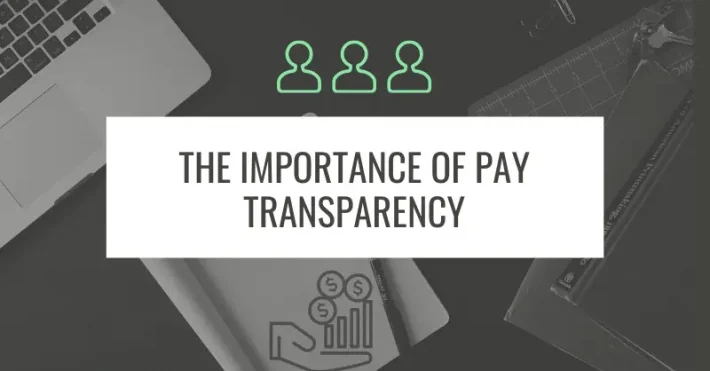We have made great strides in our work lives in the last few years. The way we think, and our working style have evolved; most importantly having conversations on delicate topics in a workplace is encouraged and supported with the right means. One of the lesser-talked subjects becoming more widespread now is the importance of pay transparency in an organization.
Globally, employees are becoming aware of more transparent procedures implemented in role-model businesses. This has given rise to a new way of thinking about salaries and discussions around them. Workers no longer want to be in the dark and have hush-hush conversations with their employers about their paychecks. They want to be paid fairly for their skills, experience, and as per market value.
Pay transparency stemmed from that very idea of equal pay regardless of gender, background, or ethnicity. Candidates must be assessed on their years of experience and skill set to be provided with a fair package on par with market standards. Benchmarking salary data allows for pay transparency and although it is still not widely adopted, employers must have honest conversations with their employees about what each role is being paid and the reason behind it.
This approach not only helps employees understand how roles and skills are valued but also opens a fact-based discussion for them to see their limitations and areas of improvement. Promotions become easier for both parties as clear distinctions can be made as to what criteria (specialized skills, higher education, market experience) satisfy the prerequisites for a pay increase.
The Shift
Although conversations around pay transparency existed prior to the pandemic, it largely increased after the onset of Covid-19 as employees working in high-stress situations – undervalued and underpaid – began evaluating their compensation and wanting more transparency as to why they were being paid what they were. This shift gave rise to an increase in surveys and data collected, to gauge the consensus of employed professionals on the matter.
Over the last few years, access to data has changed drastically. From a compensation standpoint, where previously visibility in pay scales was limited, new data collection methods and web crawling software have significantly contributed to knowledge in this area. Earlier, studies on salary benchmarking data yielded incorrect results as it wasn’t uncommon to categorize multiple jobs together in a single domain reflecting one pay range. This skewed the salary brackets for any role under that domain as clear distinctions weren’t made thus affecting transparency.
As we make the shift towards a data-centric method, the above issue has dwindled in numbers. Nowadays each domain has its specialized sub-categories and distinction in roles providing more granularity in data. The UK Standard Occupation Classification (SOC) provides a detailed overview of job categories and the multiple yet diverse roles in each domain. When each role is defined with the respective pay range, candidates have visibility from the start.
An Overview of Salary Data
The post-pandemic job market has seen significant growth in wages for certain sectors such as Hospitality, Information, and Company Management. The chart below mapped out by the PEW Research Centre shows the highest increase in average weekly wages for the ‘Accommodation and Food Services’ sector – a whopping 18.4 percent between the second quarter of 2020 and 2021. Despite the surge, the industry remains the lowest-paying sector. The next two sectors with the highest wage gains are also the highest-paying sectors in the US job market seeing a decent growth of 12.3 and 12 percent respectively, an improvement from the 2019-20 figures.
In 2022, the US Real Estate sector – one of the largest industries in the US market – had 211,600 job listings for Real Estate Sales Agents drawing an average of 50K – 100K USD. In Healthcare, one of the highest paying roles was for Psychiatrists drawing an average of 216K – 321K USD. These insights were acquired from the JobsPikr talent intelligence tool. Organizations using the software can obtain the latest labor market insights to benchmark salaries and provide fair compensation to employees.
In a recent salary benchmarking report by PromptCloud, the company performed the benchmarking exercise to analyze existing gaps and take measures to improve pay transparency. The data collected from JobsPikr allowed the HR Team to make accurate decisions on salary adjustments and negate inconsistencies. Read the complete case study here.
Normalizing Pay Transparency
For employees in numerous organizations, discussing their pay continues to be a taboo subject. Young candidates are indoctrinated by the employer not to discuss their paycheck with colleagues, a stigma they carry throughout their careers. Breaking away from this mindset is not as easy as it may seem as most people’s self-worth is inextricably linked to their paycheck.
The absence of pay transparency leads to information asymmetry allowing the employer visibility to everyone’s paychecks while employees have none. It also propagates unfair promotion standards as raises are largely based on previous earnings. While employees may believe secrecy around salaries benefit them, the only entity that stands to win is the organization.
Every company that’s focused on a people-centric ethos to work stands to benefit from implementing a salary benchmarking study, if not done already. The study then opens doors for the organization to assess how they can incorporate pay transparency policies that are closely aligned with their culture. Ideally, every business must have conversations with their employees on this topic but practically, there is no one size that fits all.
Depending on the scale of the organization, company values, and practical limitations, pay transparency may look different in every place of business. Companies gearing up to begin can start off by disclosing what the employee earns and how their salaries were calculated based on market data. This creates fair pay systems and rectifies any pay discrepancies.
Once the first two measures are implemented, organizations must provide employees with visibility on compensation structures. Salary slabs for open positions and clear guidelines for raises must be publicly shared and discussed. An open-door policy to have discussions on concerns and methods of improvement allows for heightened satisfaction in the employer-employee relationship. Once all the above processes are put in place, the final step would be complete transparency on everybody’s salary within the organization. Companies like Buffer have implemented the final step with remarkable results.
Conclusion
An objective assessment of where your organization stands in the pay transparency conversation is essential to begin any reforms within your establishment. Using a tool that provides global labor market insights is of tremendous help considering the alternative of manual arduous data collection by employees. Adopting a data-driven approach to salary compensation with transparent policies will attract new talent and retain existing employees.
To know more about our talent intelligence tool, please contact sales@jobspikr.com for a demo or product details.
*Data sourced from Tradingeconomics.com



